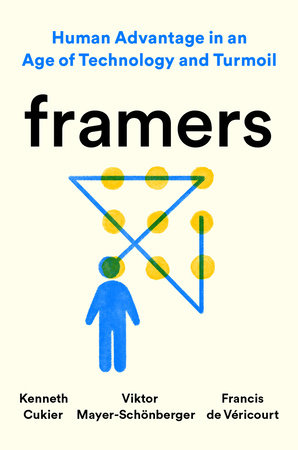Framers: Human Advantage in an Age of Technology and Turmoil
Frames are mental models of the world that we use to understand problems, and to come up with new or refined solutions. As a tool, framing has always been with us. But as long as we were focused on traits like memory and reasoning that were more obviously essential to human cognition, framing didn’t get much attention. Now that computers have become better at some of those cognitive tasks, framing stands out as a critical function—one that matters more than ever because it can’t be handed off to the machines.
Framing means dreaming with constraints, letting your mind wander in a methodical and structured way, or wondering how old tools could be applied to new problems. FRAMERS shows how framing will not just be a way to improve how we make decisions in the era of algorithms, but will be a matter of survival for humanity in the coming age of machine prosperity.
A guide to working with frames
I. Harness mental models
- Framing happens all the time but can deliberately be used to improve decisions.
- Identify and inspect the assumptions in your mental models.
- Ask “why” and “how” questions: Why did you reach this conclusion? How must the world work if you anticipate this happening?
- Imagine how a wise friend, a historical hero, or a rival might frame a certain challenge.
- Ask yourself what would need to change for you to want to frame a situation differently.
- When your views clash with another’s, try to characterize the underlying way they see the world.
II. Dream with constraints
- Applying a frame is about swiftly and efficiently identifying appropriate options.
- Focus on those elements that are most easily changeable.
- Start by making minimal changes to your constraints, and gradually contemplate more elaborate modifications.
- Be careful to remain consistent by weighing whether the change contradicts any underlying assumptions or beliefs.
- Embed constraints in a physical model if it is too difficult to keep all of them in mind at once.
III. Reframe wisely
- Switching to an alternative frame lets you see the world differently, but it is risky.
- See if you already have a frame in your repertoire that will work.
- Try repurposing a frame that you can apply from a different domain.
- Invent a new frame as a last resort, since it’s the hardest option.
- Keep in mind the trade-offs between tight frames (fast but limited) and broad ones (comprehensive but time-consuming).
- Don’t reframe repeatedly, since it leads to disorientation.
IV. Conditions matter
- We can improve our framing through cognitive diversity.
- Develop a curiosity for the unfamiliar to continually challenge your worldview.
- Be willing to accept tensions among frames: they are less an indication of faulty reasoning than of the complexity of reality.
- Speak the truth, even when it is not comforting for individuals or organizations. The courage is respected by those who matter.
- Seek dissent rather than confirmation.
- When deciding in teams, have each person frame the problem independently before sharing views and deciding as a group.
V. Think beyond yourself
- The role of society is to ensure frame pluralism to produce optimal responses in times of change.
- Strive to see the colorful; don’t be color-blind. Speak openly but respectfully about differences.
- Regard societal friction as an advantage, not a drawback.
- Use education to instill respect for others’ frames.
- Promote a commingling of cultures as a way to foster imagination, innovation, and dynamism in a society.
- Reject anything that presents itself as a single frame to encompass all of reality.
